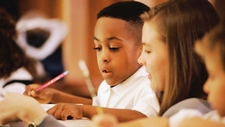Scientific Presentations

TEKS Objective
The student is expected to communicate observations with others about simple descriptive investigations.
Essential Understanding
The student uses age-appropriate tools and models to investigate the natural world.
Science Background
How to Deliver a Good Oral Presentation: Discovery Education (website) - From a comprehensive website on science fairs, this article provides tips to teachers and students on presenting ideas and information verbally.
How to Deliver a Good Oral Presentation
Discovery Education, school.discoveryeducation.com
Signature Lesson
Exploring Parts and Wholes: Science NetLinks (website) - Students explore the concept of “parts” and “wholes” while examining, analyzing and communicating their observations of parts of toys, classroom objects, and outdoors items.
Exploring Parts and Wholes
Science NetLinks, sciencenetlinks.com
- Supporting Lessons
- Extensions
- Assessment Ideas
- Literature Connections
- Related
TEKS - Additional Resources
Supporting Lessons
Color Burst: Science NetLinks (website) - During this lesson on separation of colors in water, students learn to communicate findings from their own investigations.
Elaboration Lessons and Extensions
Tree Journal: Houghton Mifflin Company (website) - Students develop their observation skills by applying their senses to study the life in and around a single tree. After they are finished with the investigation, students illustrate their findings in a nature journal and share their drawings with the class.
Tree Journal
Houghton Mifflin Company, www.eduplace.com
Air Under Water: FOSSWEB (PDF) - Students investigate air pressure by submerging a vial into a basin of water, and then communicate their observations with others. (Use the No. 8 reproducible sheet.)
Assessment Ideas
Drops on Pennies: PBS Kids (website) - In this simple, descriptive investigation, students predict how many drops of water will fit on a penny and then test their predictions. Students record and communicate their findings, and justify their explanations to the class.
Literature Connections
Scientists Ask Questions. Garrett, Ginger (ISBN-13: 978-0516246628)
What is Science? Dotlich, Rebecca Kai (ISBN-13: 978-0805073942)
Additional Resources
Making Observations: BrainPOP (website) - Activity ideas, including bird watching and “observing” objects without sight (while blindfolded), that increase students’ observation skills and abilities to communicate observations to their classmates.
TEKS Navigation
Grade 1
Need Assistance?
If you need help or have a question please use the links below to help resolve your problem.

Comments